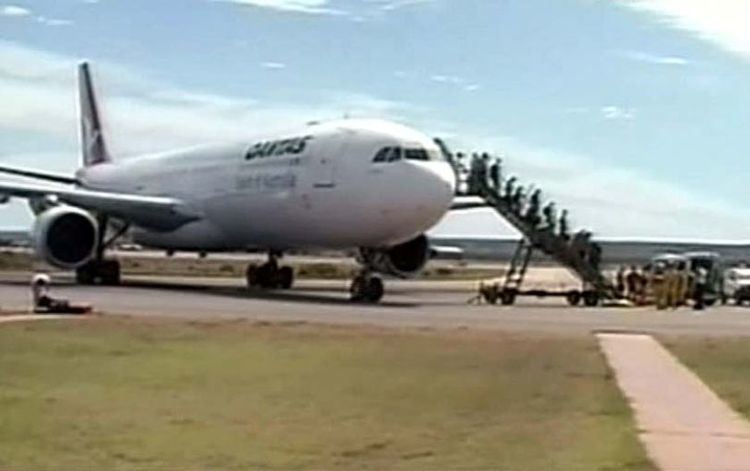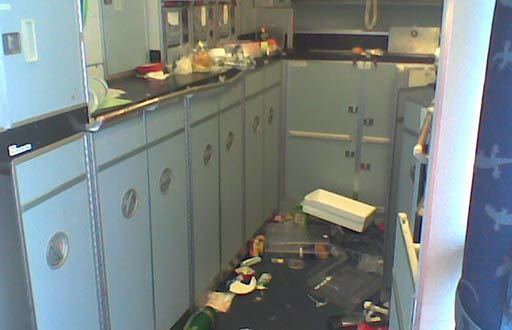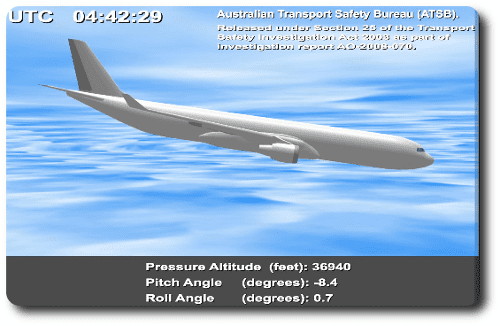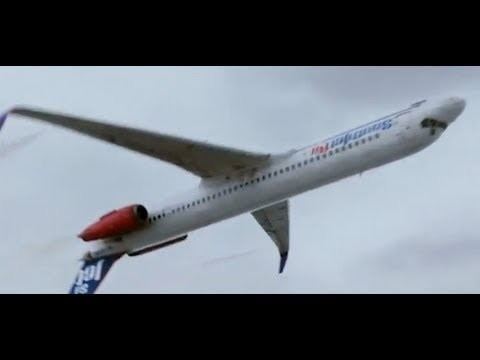Site 80NM from Learmonth Crew 12 Survivors 315 (all) Number of deaths 0 Passenger count 303 | Passengers 303 Fatalities 0 Date 7 October 2008 Injuries (nonfatal) 115 Survivor 315 (all) | |
 | ||
Summary In-flight upset, Software error Similar Qantas Flight 30, Sudan Airways Flight 109, Yeti Airlines Flight 103, Iran Aseman Airlines Fl, Blue Wing Airlines 2008 pla | ||
Qantas Flight 72 (QF72) was a scheduled flight from Singapore Changi Airport to Perth Airport on 7 October 2008 that made an emergency landing at Learmonth airport near the town of Exmouth, Western Australia following an inflight accident featuring a pair of sudden uncommanded pitch-down manoeuvres that severely injured many of the passengers and crew. The injuries included fractures, lacerations and spinal injuries. At Learmonth, the plane was met by the Royal Flying Doctor Service and CareFlight, where 14 people were airlifted to Perth for hospitalisation, with 39 others also attending hospital. Two planes were sent by Qantas to Learmonth to collect the remaining passengers and crew. In all, 1 crew member and 11 passengers suffered serious injuries, while 8 crew and 95 passengers suffered minor injuries. The Australian Transport Safety Bureau investigation found fault with one of the aircraft's three Air Data Inertial Reference Units and a previously unknown software design limitation of the Airbus A330's fly by wire flight control primary computer (FCPC).
Contents
- Aircraft
- Flight details
- Investigation
- FCPC design limitation
- Final report
- Subsequent Qantas Flight 71 incident
- Compensation
- References

Aircraft

VH-QPA was delivered new to Qantas on 26 November 2003, initially as an A330-301. It later had a change in engine type fitted and was re-designated as an Airbus A330-303 in November 2004.
Flight details

The accident began at 12:40:28 WST. The aircraft was travelling at around 37,000 feet (11,000 m) when pilots received an electronic message warning them of an irregularity with autopilot and inertial reference systems. The autopilot disengaged automatically, and the aircraft climbed 200 feet (60 m) under manual control. The autopilot was re-engaged when the aircraft returned to the prior selected flight level before the autopilot was disengaged for the remainder of the flight. At 12:42:27 the aircraft made a sudden uncommanded pitch down manoeuvre, recording -0.8 g, reaching 8.4 degrees pitch down and rapidly descending 650 feet (200 m) in about 20 seconds before the pilots were able to return the aircraft to the assigned cruise flight level. At 12:45:08 the aircraft then made a second uncommanded manoeuvre of similar nature, this time reaching +0.2 g, 3.5 degrees pitch down and descending 400 feet (120 m) in about 16 seconds before being returned to level flight. Unrestrained passengers and crew as well as some restrained passengers or/and board were flung around the cabin or crushed on with overhead luggage as well as crashing with overhead compartments. The pilots stabilised the plane and declared a state of alert (pan-pan), which was later updated to mayday when the extent of injuries was relayed to the flight crew.
Investigation

The ATSB investigation is supported by the Australian Civil Aviation Safety Authority (CASA), Qantas, the French Bureau d'Enquêtes et d'Analyses pour la sécurité de l'Aviation Civile (BEA) and Airbus. Copies of data from the aircraft's flight data recorder and cockpit voice recorder were sent to the BEA and Airbus.

The aircraft was equipped with a Northrop Grumman made ADIRS, which investigators sent to the manufacturer in the US for further testing. On 15 January 2009 the EASA issued an Emergency Airworthiness Directive to address the above A330 and A340 Northrop-Grumman ADIRU problem of incorrectly responding to a defective inertial reference.
The Australian Transport Safety Bureau (ATSB) identified in a preliminary report that a fault occurred within the Number 1 Air Data Inertial Reference Unit (ADIRU) and is the "likely origin of the event". The ADIRU (one of three such devices on the aircraft) began to supply incorrect data to the other aircraft systems.
The initial effects of the fault were:


About two minutes later, ADIRU No. 1, which was providing data to the captain's primary flight display, provided very high (and false) indications for the aircraft's angle of attack (AOA), leading to:
FCPC design limitation
AOA (Angle Of Attack sensor) is a critically important flight parameter, and full-authority flight control systems such as those equipping A330/A340 aircraft require accurate AOA data to function properly. The aircraft was fitted with three ADIRUs to provide redundancy and enable fault tolerance, and the FCPCs used the three independent AOA values to check their consistency. In the usual case, when all three AOA values were valid and consistent, the average value of AOA 1 and AOA 2 was used by the FCPCs for their computations. If either AOA 1 or AOA 2 significantly deviated from the other two values, the FCPCs used a memorised value for 1.2 seconds. The FCPC algorithm was very effective, but it could not correctly manage a scenario where there were multiple spikes in either AOA 1 or AOA 2 that were 1.2 seconds apart.
As with other safety-critical systems, the development of the A330/A340 flight control system during 1991 and 1992 had many elements to minimise the risk of a design error. These included peer reviews, a system safety assessment (SSA), and testing and simulations to verify and validate the system requirements. None of these activities identified the design limitation in the FCPC’s AOA algorithm.
The ADIRU failure mode had not been previously encountered, or identified by the ADIRU manufacturer in its safety analysis activities. Overall, the design, verification and validation processes used by the aircraft manufacturer did not fully consider the potential effects of frequent spikes in data from an ADIRU.
Airbus has stated that they are not aware of a similar incident occurring previously on an Airbus aircraft. Airbus has released an Operators Information Telex to operators of Airbus A330 and A340 aircraft with procedural recommendations and checklists to minimise risk in the event of a similar incident.
The ATSB's continuing accident investigation will include assessment of speculation that possible interference from Naval Communication Station Harold E. Holt or passenger personal electronic devices could have been involved, although based on initial analysis, the Bureau believes these are unlikely to have been of any impact.
Final report
The ATSB's final report issued on 19 December 2011 concluded that the incident "occurred due to the combination of a design limitation in the flight control primary computer (FCPC) software of the Airbus A330/Airbus A340, and a failure mode affecting one of the aircraft's three air data inertial reference units (ADIRUs). The design limitation meant that, in a very rare and specific situation, multiple spikes in angle of attack (AOA) data from one of the ADIRUs could result in the FCPCs commanding the aircraft to pitch down."
Subsequent Qantas Flight 71 incident
On 27 December 2008, a Qantas A330-300 aircraft operating from Perth to Singapore was involved in an occurrence approximately 260 nautical miles (480 km) north-west of Perth and 350 nautical miles (650 km) south of Learmonth Airport at 1729 WST while flying at 36,000 feet. At this time, the autopilot disconnected and the crew received an alert indicating a problem with ADIRU Number 1. The crew actioned the revised procedure released by Airbus after the earlier accident and returned to Perth uneventfully. The ATSB will include the incident in their existing accident investigation. The incident again fuelled media speculation regarding the significance of the Harold E. Holt facility, with the Australian and International Pilots Association calling for commercial aircraft to be barred from the area as a precaution until the events are better understood, while the manager of the facility has claimed that it is "highly, highly unlikely" that any interference has been caused.
Compensation
In the aftermath of the accident, Qantas offered compensation to all passengers. The airline announced it would refund the cost of all travel on their itineraries covering the accident flight, offer a voucher equivalent to a return trip to London applicable to their class of travel and pay for medical expenses arising from the accident. Further compensation claims would be considered on case by case basis, with several passengers from the flight pursuing legal action against Qantas. Some have asserted that they were wearing their seatbelts at the time of the incident and some have questioned Qantas' handling of their cases.
